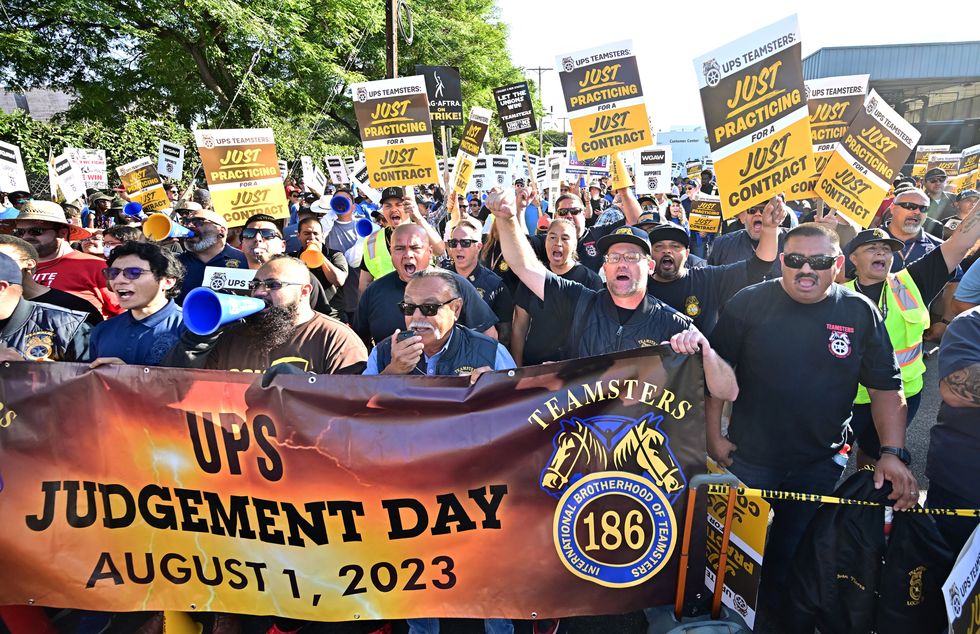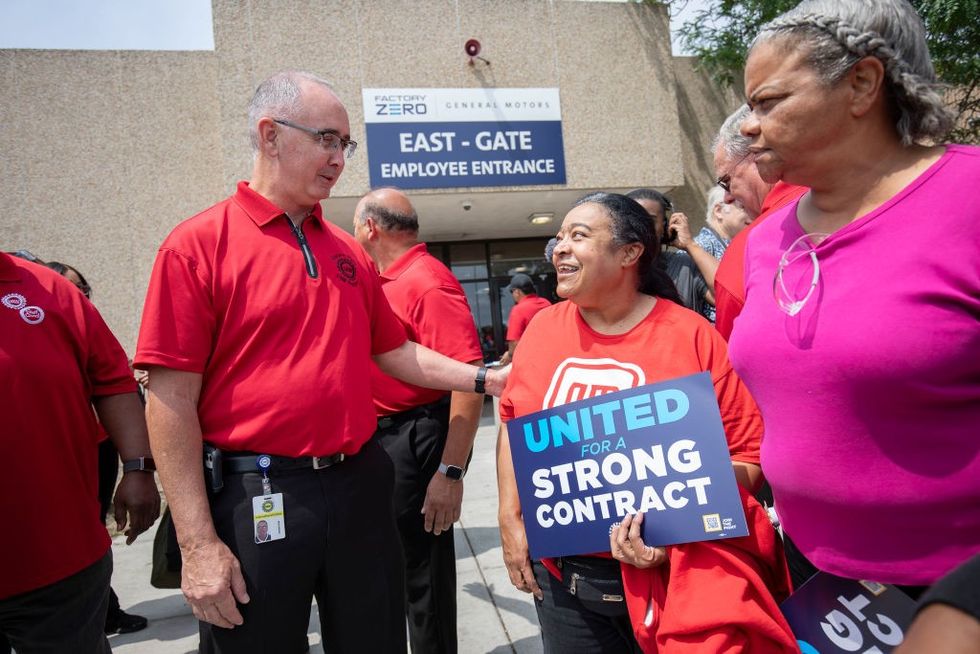

SUBSCRIBE TO OUR FREE NEWSLETTER
Daily news & progressive opinion—funded by the people, not the corporations—delivered straight to your inbox.
5
#000000
#FFFFFF
To donate by check, phone, or other method, see our More Ways to Give page.


Daily news & progressive opinion—funded by the people, not the corporations—delivered straight to your inbox.
Inter-union collaboration is scaffolding a historic U.S. strike wave.
Speaking outside Amazon Studios in Culver City, California, last week to a crowd of striking actors, writers, and Amazon delivery drivers, Teamsters General President Sean O’Brien spotlighted the growing prominence of cross-union solidarity in the United States.
“The great thing that’s happening right now in the labor movement, we are for one time—and I’ve been a Teamster for 33 years—collaborating with each other in a power collaboration to truly effectuate change,” O’Brien said.
Citing Amazon’s powerful role in both the logistics and entertainment industries, O’Brien called the tech behemoth a “common enemy.” (This spring, 84 Amazon drivers in Southern California unionized with Teamsters Local 396 and have been on strike since June 24 over alleged unfair labor practices.)
“It’s very simple for us to stand together, and that’s obviously something that we haven’t done throughout our history here in Hollywood.”
“We can have our arguments amongst ourselves right here and that’s okay,” the Teamsters president said to the assembled picketers from multiple unions. “But… we identify who our common enemies are and… we make certain they understand that you take one of us on, you take all of us on.”
Since July 14, 160,000 film and television actors with the Screen Actors Guild-American Federation of Television and Radio Artists (SAG-AFTRA) have been on strike alongside 11,000 screenwriters with the Writers Guild of America (WGA), who themselves have been on strike since May 2.
The two unions are fighting to secure new contracts from the big studios and streamers that include improvements around job security, healthcare, and residuals, as well as protections from the use of artificial intelligence.
The Teamsters and the International Alliance of Theatrical Stage Employees (IATSE)—the unions representing Hollywood’s “below-the-line” workers such as camera operators, gaffers, costumers, makeup artists, mechanics, drivers, and others—have repeatedly expressed solidarity with the striking writers and actors.
In the early weeks of the writers’ strike, before SAG-AFTRA’s work stoppage served to halt all filming, IATSE and Teamsters members were instrumental in shutting down production on several TV shows by refusing to work on sets where WGA members were picketing. The Teamsters and IATSE contracts protect members from employer discipline when they choose to honor other unions’ picket lines.
With production shut down or slowed down, below-the-line workers are facing furloughs and unemployment, yet are still showing their support for the strikes. Rank-and-file writers and directors recently launched the Union Solidarity Coalition to help raise money for crewmembers who have lost their health insurance during the strikes.
In a statement, IATSE International President Matthew D. Loeb blamed the studios for the financial hardship: “Make no mistake—if the studios truly cared about the economic fallout of their preemptive work slowdown against below-the-line crewmembers, they could continue to pay crewmembers and fully fund their healthcare at any moment, as they did in 2020 during the onset of the Covid-19 pandemic.”
Such inter-union collaboration has not always been prevalent in the U.S. labor movement, especially in Hollywood, where it has been 63 years since both the writers’ and actors’ guilds were on strike together.
More notoriously, Hollywood’s craft unions have an ugly history of battling each other over jurisdiction, such as when IATSE and the short-lived Conference of Studio Unions feuded in the mid-1940s over who would get to represent set decorators. That dispute exploded into a violent brawl between hundreds of members of the two rival unions outside Warner Bros. Studios on October 5, 1945, an event often remembered as “Hollywood Black Friday.”
“It’s very simple for us to stand together, and that’s obviously something that we haven’t done throughout our history here in Hollywood,” Teamsters Motion Picture Division director Lindsay Dougherty told the crowd at last week’s Amazon Studios picket. “But we’re changing the history in Hollywood right fucking now.”

UPS Teamsters rally in Los Angeles.
(Photo: Frederic J. Brown/AFP via Getty Images)Beyond Hollywood, on July 25, the Teamsters secured what the union calls “the most historic tentative agreement for workers in the history of UPS” just six days before a possible strike at the shipping giant would have started. With the union representing 340,000 delivery drivers, loaders, and sorters at UPS, it would have been one of the largest single-employer strikes in U.S. history.
The tentative deal includes historic pay increases (including a $21-per-hour minimum wage for new part-time employees), a commitment from the company to install air conditioning in trucks, and an end to the two-tier wage system, among other significant improvements.
In the run-up to the potential work stoppage, the Independent Pilots Association (IPA), the union representing the 3,300 pilots who operate UPS’s fleet of nearly 280 aircrafts, had promised to stand with the Teamsters.
“If Teamsters decide they need to go on strike, then without even questioning, the pilots say we’re gonna honor that picket line.”
In a July 3 letter to O’Brien, IPA President Capt. Ron Travis vowed “to honor any potential [Teamsters] strike and act in sympathy with our fellow workers at UPS by not working.”
“As joint allies in the pursuit of enhanced safety standards, industry leading wages and benefits, and improved quality of life for our members, let’s continue to ensure that our organizations communicate, collaborate, and support each other as much as possible,” Travis wrote. “Unity generates success.”
In the past, the Teamsters similarly pledged to stand with the pilots during the IPA’s own contract negotiations. The IPA’s current contract with UPS expires in 2025.
IPA spokesperson Brian Gaudet told In These Times that the close relationship between the two unions was “cemented” during the Teamsters’ historic 16-day strike at UPS in 1997, when “not one of our pilots crossed the picket line.”
“If Teamsters decide they need to go on strike, then without even questioning, the pilots say we’re gonna honor that picket line,” Gaudet said before the tentative deal was reached. “These unions have each other’s back.”
At the same time, UPS’s 111 flight dispatchers—who are members of Transport Workers Union (TWU) Local 592 and based in Louisville, Kentucky—had also promised to honor the potential Teamsters’ work stoppage.
“If the Teamsters put a picket line up at UPS in Louisville, where our air dispatchers work, we’re not going to cross that picket line. It’s as simple as that,” said TWU International President John Samuelsen.
“It’s just the right thing to do to support the Teamsters in their fight,” Samuelsen told In These Times, adding that unions honoring each other’s strikes is crucial to victory. “If the labor movement is going to be strong, this is how it must be,” he said.

United Auto Workers president Shawn Fain speaks with and does “members’ handshakes” with General Motors workers at GM Factory Zero on July 12, 2023 in Detroit, Michigan.
(Photo: Bill Pugliano/Getty Images)
To gear up for a potential strike, in the two weeks before a tentative agreement was reached, thousands of UPS Teamsters and their labor allies organized numerous practice pickets and rallies around the country.
At one such rally held in New Hyde Park, New York, on July 15, local Teamsters were joined by members of the United Auto Workers (UAW) and recently-elected UAW President Shawn Fain.
This fall, 150,000 UAW members at the Big 3 automakers could also go on strike to secure a new contract. With the current contract set to expire in September, negotiations between the union and Ford, General Motors, and Stellantis began earlier this month.
“Wall Street would love for us to think that factory workers, that delivery drivers, that hotel workers, that writers and actors have nothing in common.”
“The Teamsters’ fight is our fight. Our fight’s got to be theirs,” Fain told The Upsurge’s Teddy Ostrow at the New Hyde Park event. “Labor has to come together—no matter what sector, no matter what division, no matter what the work is. You look at the Teamsters’ path, you look at our path. It’s parallel.”
Samuelsen of the TWU predicted that the Teamsters’ practice pickets, along with the pledges of solidarity from his union and the IPA, could avert a strike.
“The best way to avoid a strike is to be prepared to win a strike,” Samuelsen told In These Times before the Teamsters and UPS reached a deal. “I wouldn’t be shocked if UPS—in a typically cowardly, sort of bully, boss mentality—once they realize that the workforce is prepared to win, they’ll settle.”
Back in Southern California, WGA and SAG-AFTRA strikers have been exercising labor unity by joining the picket lines of the 15,000 striking Los Angeles hotel workers with UNITE HERE Local 11 and the striking Amazon drivers with Teamsters Local 396.
“Wall Street would love for us to think that factory workers, that delivery drivers, that hotel workers, that writers and actors have nothing in common,” SAG-AFTRA Executive Vice President Ben Whitehair said at a recent labor solidarity rally in Los Angeles. “But you all know that is not the case.”
At last week’s picket outside Amazon Studios, Teamsters president O’Brien promised continued solidarity with other unions.
“Once we’re done kicking the shit out of UPS, which is gonna be very soon, we’re gonna focus on kicking the shit out of all these greedy white-collar criminals known as Hollywood,” O’Brien said. “When you fuck with SAG, you fuck with the screenwriters, you fuck with the Teamsters, put your helmets on, buckle your chinstraps—it’s a full-contact sport.”